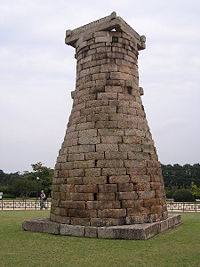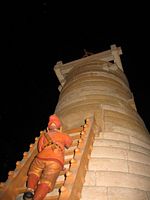Cheomseongdae
| Cheomseongdae | ||||||||
|---|---|---|---|---|---|---|---|---|
 | ||||||||
| Korean name | ||||||||
|
A stone astronomical observatory in Gyeongju, South Korea, Cheomseongdae is considered the earliest significant archeological site in Korea dating back to the 7th century before the Unified Shilla dynasty. Considered the oldest existing observatory in East Asia, Cheomseongdae (Nearer the Stars Palace) is a familiar symbol on Korean coins and in travel literature, often symbolizing Korea itself. On December 20 1962, the Korean government designated Cheomseongdae their 31st national treasure
Structure Described
Cheomseongdae's construction style parallels that used at the Bunhwangsa Temple in Gyeongju. The tower is 5.7 meters wide at the base and 9.4 meters tall, and filled with earth up to the level of the window. Cylindrical in shape, it resembles the upper part of a coca cola bottle. An opening is constructed half way up the structure. The astromomer is thought to have gained entry into the tower through the opening by climbing a ladder (see the image below). Today, dirt fills the tower to the opening level. Archeologists believe that the star gazer reached the top of the structer by way of another ladder inside.
Resting on the top of the tower, eight rectangular stones (8 feet by 6 feet) are positioned to form two squares. Inside the tower from the opening, two sets of stone bars are positioned parallel to the top of the opening. Archeologists believe that those stones supported the stairway to the top.
The tower is built out of 362 pieces of cut granite which some claim represent the 362 days of the moon|lunar year. Some surveys of the site have indicated that there are 366 blocks. It has 27 circular layers of stones (some associate it with the fact that Queen Seondeok was considered to be the 27th ruler of Silla) surmounted by a square structure. 12 of the layers are below the window level and 12 are above. There are 12 large base stones set in a square, with three stones on each side. These sets of 12 may symbolize the months of the year.
History
According to Samguk Yusa, Cheomseongdae was constructed under the reign of Queen Seondeok (r. 632-647) (선덕여왕) near the capital of the kingdom. Seondeok became the first queen to rule Silla after her father, King Jinpyeong of Silla (r. 579-632) (26th king), died without a son. The Queen ordered Cheomseongdae built in the early 7th century.
Koreans have had a fascination with the stars from its earliest history. Koreans believe influences from the stars dictate the happenings in the universe, history, society, and the person's life. That view came from China, maintaining that the movement of the heavenly bodies determine the course of history and people's lives. The line between astronomy and astrology sometimes blurred. Yet, undeniably, Koreans interest in the precise nature of the movement of the heavenly bodies for over 2000 years has led to a large body of astronomical knowledge. That Cheomseongdae has become a national symbol is fitting, since the observation tower represents Korean's quest for scientific and philsophical knowledge.
The Cheomseongdae is one of the oldest surviving observatories in East Asia, though some claim that Cheomseongdae was not suitable for astronomical observation. Others posit that it was used for astrology rather than astronomy, though during that era there was little differentiation between the two. Some scholars have argued that the Cheomsongdae's design was heavily influenced by Buddhism, noting similarities between its design and Mount Sumeru, the center of the world according to Buddhist mythology.
Notes
ReferencesISBN links support NWE through referral fees
- Jeon, Sang-woon. (1998). A history of science in Korea. Seoul:Jimoondang. ISBN 89-88095-11-1
- Nha, Il-seong. Silla's Cheomseongdae. (2001) Korea Journal 41(4), 269-281. [1]
- Song, Sang-Yong. (1983). A brief history of the study of the Ch'ŏmsŏng-dae in Kyongju. Korea Journal 23(8), 16-21. [2]
External links
- Asian Historical Architecture page on Cheomseongdae
- Travel in Korea Cheomsongdae information page
- [3]Indiana University Resources. Retrieved February 13th, 2006.
- [4]. Indiana University Resources Retrieved February 13th, 2006.
Credits
New World Encyclopedia writers and editors rewrote and completed the Wikipedia article in accordance with New World Encyclopedia standards. This article abides by terms of the Creative Commons CC-by-sa 3.0 License (CC-by-sa), which may be used and disseminated with proper attribution. Credit is due under the terms of this license that can reference both the New World Encyclopedia contributors and the selfless volunteer contributors of the Wikimedia Foundation. To cite this article click here for a list of acceptable citing formats.The history of earlier contributions by wikipedians is accessible to researchers here:
The history of this article since it was imported to New World Encyclopedia:
Note: Some restrictions may apply to use of individual images which are separately licensed.
